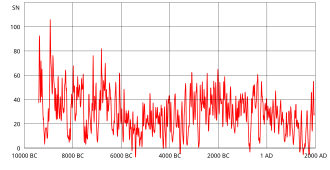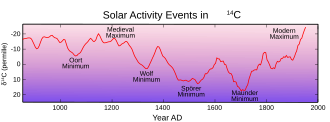Solar cycle


File:Evolution of Magnetism on the Sun.ogv



Solar Cycle
The Solar Cycle, also known as the sunspot cycle, is a nearly periodic 11-year change in the Sun's activity measured in terms of variations in the number of observed sunspots on the solar surface. Sunspots are regions of reduced surface temperature caused by concentrations of magnetic field flux that inhibit convection. The cycle is produced by the solar magnetic activity cycle and is the most prominent aspect of the Sun's larger 22-year magnetic cycle known as the Hale cycle.
Overview[edit]
The Solar Cycle affects all layers of the solar atmosphere, influencing space weather and geomagnetic activities through the emission of solar flares, the ejection of coronal mass ejections (CMEs), and variations in solar wind and solar irradiance. These in turn can affect satellite operations, communication systems, and even power grids on Earth.
History[edit]
The existence of the solar cycle was first observed in 1843 by Samuel Heinrich Schwabe, who after 17 years of observations noticed a periodic variation in the number of sunspots. Rudolf Wolf later compiled and studied these observations, formalizing the method to calculate the sunspot number to monitor the solar cycle's progress.
Phases of the Solar Cycle[edit]
The solar cycle can be divided into several phases, primarily characterized by the rise to a maximum and then a decline to a minimum in sunspot numbers. These phases are:
1. Minimum Solar Activity: Characterized by few to no sunspots, this phase marks the beginning of a new solar cycle. 2. Ascending Phase: Sunspot numbers increase, leading to more frequent solar flares and CMEs. 3. Solar Maximum: The peak phase of the cycle, with the highest number of sunspots and solar activity. 4. Descending Phase: Sunspot numbers and solar activity decrease. 5. Minimum Solar Activity: The cycle ends as it returns to a period of minimal sunspots, before beginning anew.
Impact on Earth[edit]
The Solar Cycle has significant effects on Earth's climate and space environment. During solar maximum, the increased solar activity can lead to more intense Northern Lights (aurora borealis) and Southern Lights (aurora australis). However, it can also pose risks to satellite integrity, increase radiation exposure to astronauts, and affect power grid operations.
Predicting the Solar Cycle[edit]
Predicting the characteristics of future solar cycles is an area of ongoing research. Various models and methods are used, including statistical analysis and dynamo theory, but predicting the exact timing and strength of solar cycles remains challenging.
Solar Cycle 25[edit]
The current cycle, Solar Cycle 25, began in December 2019, as announced by the Solar Cycle 25 Prediction Panel, an international group of experts. Early predictions suggest that Solar Cycle 25 will be similar in strength to its predecessor, Solar Cycle 24, which was below average in activity compared to previous cycles.
Ad. Transform your life with W8MD's Budget GLP-1 injections from $75


W8MD offers a medical weight loss program to lose weight in Philadelphia. Our physician-supervised medical weight loss provides:
- Weight loss injections in NYC (generic and brand names):
- Zepbound / Mounjaro, Wegovy / Ozempic, Saxenda
- Most insurances accepted or discounted self-pay rates. We will obtain insurance prior authorizations if needed.
- Generic GLP1 weight loss injections from $75 for the starting dose.
- Also offer prescription weight loss medications including Phentermine, Qsymia, Diethylpropion, Contrave etc.
NYC weight loss doctor appointmentsNYC weight loss doctor appointments
Start your NYC weight loss journey today at our NYC medical weight loss and Philadelphia medical weight loss clinics.
- Call 718-946-5500 to lose weight in NYC or for medical weight loss in Philadelphia 215-676-2334.
- Tags:NYC medical weight loss, Philadelphia lose weight Zepbound NYC, Budget GLP1 weight loss injections, Wegovy Philadelphia, Wegovy NYC, Philadelphia medical weight loss, Brookly weight loss and Wegovy NYC
|
WikiMD's Wellness Encyclopedia |
| Let Food Be Thy Medicine Medicine Thy Food - Hippocrates |
Medical Disclaimer: WikiMD is not a substitute for professional medical advice. The information on WikiMD is provided as an information resource only, may be incorrect, outdated or misleading, and is not to be used or relied on for any diagnostic or treatment purposes. Please consult your health care provider before making any healthcare decisions or for guidance about a specific medical condition. WikiMD expressly disclaims responsibility, and shall have no liability, for any damages, loss, injury, or liability whatsoever suffered as a result of your reliance on the information contained in this site. By visiting this site you agree to the foregoing terms and conditions, which may from time to time be changed or supplemented by WikiMD. If you do not agree to the foregoing terms and conditions, you should not enter or use this site. See full disclaimer.
Credits:Most images are courtesy of Wikimedia commons, and templates, categories Wikipedia, licensed under CC BY SA or similar.
Translate this page: - East Asian
中文,
日本,
한국어,
South Asian
हिन्दी,
தமிழ்,
తెలుగు,
Urdu,
ಕನ್ನಡ,
Southeast Asian
Indonesian,
Vietnamese,
Thai,
မြန်မာဘာသာ,
বাংলা
European
español,
Deutsch,
français,
Greek,
português do Brasil,
polski,
română,
русский,
Nederlands,
norsk,
svenska,
suomi,
Italian
Middle Eastern & African
عربى,
Turkish,
Persian,
Hebrew,
Afrikaans,
isiZulu,
Kiswahili,
Other
Bulgarian,
Hungarian,
Czech,
Swedish,
മലയാളം,
मराठी,
ਪੰਜਾਬੀ,
ગુજરાતી,
Portuguese,
Ukrainian
